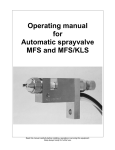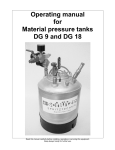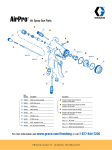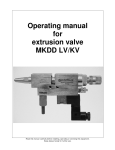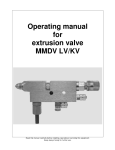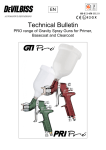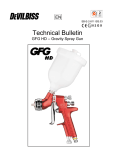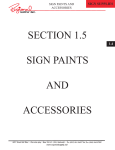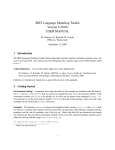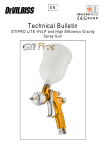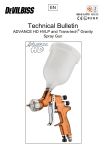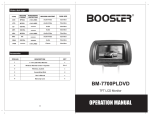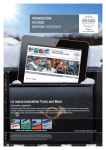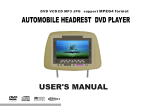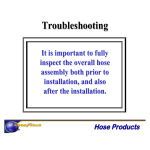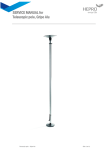Download Operating manual for automatic
Transcript
Operating manual for automaticspray valve ASV Read this manual carefully before installing, operating or servicing this equipment. Keep always handy for further use. ALFRED SCHÜTZE Apparatebau GmbH - Spritztechnik – Spraytechnology Hannoversche Straße 69-71, 28309 Bremen – Germany; Postfach 44 86 48, 28286 Bremen - Germany Tel.: 0049 (0)421 / 43510-0; Fax: 0049 (0)421 / 43510-43 Internet: http://www.schuetze-gmbh.de E-Mail: [email protected] 1 Introduction The automatic spray valve ASV is designed and constructed for application of thin materials f.i. release agents, oils, colours and in version KLS also for glues and adhesives. Depending on position of continuously adjustable regulation of sprayjet, this spray valve sprays from round- to 90° flatspray. Depending on viscosity of fluid, the application can be adjusted individually via nozzle dimension, atomizing air pressure, material pressure and the continuously adjustable sprayjet regulation. The supply of atomizing air, control air and material should be done via three hoses (with remote-controlled regulation of sprayjet = four hoses). Spray valves are precision tools. Always keep clean and observe minimum instructions to maintain a long useful life of the valve. 2 Safety 2.1 Duties of the user • • The user must read this service manual carefully before performing any operations. Application and service operations should not be carried out if the user is not absolutely sure of the purpose and consequence of the operations. 2.2 Definitive Use The automatic spray valve ASV is a pneumatically controlled needle valve. It is suitable for continuously or intermittent use. They are not suitable for spraying aggressive fluids like acid, alkaline solutions, cleaning agents, chemicals etc.. In case of doubt, please contact the manufacturer. 2.3 Warning against danger This operating manual warns users of operations which may put their health at risk. The warnings are indicated by combinations of text and symbols corresponding to the different danger classes. WARNING! Signs a possible dangerous situation. If you don´t avoid, death or severe injuries can follow. CAUTION! Indicates a situation which may be dangerous. Failure to heed the caution may result in personal injury. This indication is also used where material damage is possible. IMPORTANT! Indicates tips for usage and other helpful information. 3 Function Description The automatic spray valve ASV is pneumatically controlled: air open; spring return. The spraying material is to be fed to the valve via pressure tank or pump. The separate controlled atomizing air atomizes the material to a spray jet. Depending on position of continuously adjustable sprayjet regulation, the valve sprays from a round- up to a 90° flatspray. 4 Installation The automatic spray valve ASV can be installed in any position. For solid attachment the use of clamp (option, drawing no.: 15.0) is recommend. Vibration of the equipped machine to the valve should be limited as far as possible. Vibrations of the valve caused by fast intermitting cycles require solid and massive installation. 4.1 Hose connection and assembly Connect hoses for atomizing air and control air to seperatly control valves (pressure reducers and solenoids). Then fluidhose to material pressure tank or other means of feeding fluid as under: • atomizing air, marked with “Z” (draw.-no.: 6.0, hose blue): Î to 2/2 way solenoid • control air, marked with “S” (draw.-no.: 6.0, hose black): Î to 3/2 way solenoid • fluid, marked with “M” (draw.-no.: 6.0, hose transparent): Î to feeding device OPTIONAL: • • remote-controlled regulation of sprayjet, Î to 2/2 way solenoid material circulation, Î back to feeding device (draw.-no.: 16.0, hose blue): (draw.-no.: 6.0, hose black): 4.2 Spray pattern regulation Turn the spray pattern regulator (7.0) to adjust the spray pattern. Turn anti-clockwise for a wider jet spray and clockwise for a rounder spray. The adjustment is continuous, not in steps. Optionally the spray pattern regulation can be done pneumatically controlled. For this option turn spray pattern regulator (7.0) clockwise completely. Now the regulation of atomizing air for the cone holes can be done via additional air connection M5 (16.0) via pressure regulator remote-controlled. 4.3 Operating instructions CAUTION ! Never point the sprayjet against persons. Wearing eye protection is strongly recommended. Spraying procedures cause noises depending on the used pressure. If necessary, wearing of ear protection is recommend. WARNING ! Danger caused by combustible and noxious spraying material. Safety instructions on fluid can and material data of fluid manufacturer must definitely be observed. The automatic spray valve ASV needs 3,5 – 6 bar control air pressure. Atomizing air pressure and material pressure should be as low as possible. In any case, please observe the regulations of the professional/trade association having liability for industrial safety and insurance. When you are certain, that fluid pressure stands up to the nozzle, actuate 2/2 way solenoid for atomizing air. After that actuate 3/2 way solenoid for control air. This way you reveive socalled “pre-air” prior to opening fluid flow. After each cycle solenoids are to actuate in reverse order, so you will still have “purging-air” after needle has closed nozzle and fluid flow was stopped. This prevent fluid to form out drops instead of being atomized. Set atomizing air pressure and fluid pressure according to required spray droplet sizes. Two separate pressure reducers must be available. Intermittend use as well as continuous use is possible. Maximal 40 cycles per second are possible (under optimal working conditions). IMPORTANT ! The quantity of fluid flow can be adjusted by the regulating knob (draw.-no.: 13.0). Turning this knob in anti-clockwise turn = more fluid flow Turning this knob in clockwise turn = less fluid flow Do not over-tight the regulating knob. IMPORTANT ! To avoid damages to nozzle and needle adjust decrease of fluid flow (turning regulating knob 16.0 clockwise) only when fluid is emitted from the nozzle. This is the only way to observe the steady reduction of fluid flow until an absolute stop of fluid. Going on to turn the regulating knob clockwise would at once push the needle into the nozzle to such an extant that both parts could be damages. It is harmless to leave fluid within the valve (no connection to outside air), if system stays under pressure. 5 Repair and Maintance Before starting maintenance or repair work, ensure that all air operated tools are disconnected from the air supply. WARNING ! Danger caused by combustible and noxious spraying material. Safety instructions on fluid can and material data of fluid manufacturer must definitly be observed. WARNING ! Before opening the spray valve it has to be disconnected from the air and fluid supply. Otherwise ejected elements can cause danger. The automatic spray valve ASV is a high precision tool. Always keep clean and observe minimum instructions to maintain a long and useful life of valve. We recommend lubricating moveable parts regularly, and greasing threads, especially the nozzle threads, when replacing or cleaning the nozzle. It is recommended to use clean and filtered application fluid only. Also atomizing air should be clean. Control air should be slightly oiled. 5.1 Cleaning To clean valve, spray solvent until pure solvent leaves nozzle. Do not submerge entire valve in solvent. At longer working interruptions it is advisable to clean air cap and nozzle by putting these parts only into solvent. If necessary use a soft brush. Moving parts and threads should alway be greased slightly. The spray valve should be cleaned using an appropiate thinner. To clean small drill holes, use our special nozzle cleaning needles. These spray valves are high precision tools. Always keep clean and observe minimum instructions to maintain a long and useful life of valve. We recommend lubricating moveable parts regularly, and greasing threads, especially the nozzle threads, when replacing or cleaning the nozzle. 5.2 Possible case of failure: Needle sticks • • • • Check, if sufficient control / operating air is supplied (3,5 - 6 bar). Check, if o-ring (9.1) is in propper order. Check, if needle is dirted by f.i. glue residues or sticks within needle gasket (8.1 / 8.4) or within nozzle. Check, if minimum of travel of needle is set. Troube shooting. • • If drops form on the nozzle, either needle or nozzle is worn out and should be replaced. Or needle is not closing properly f.i. because particle residues within nozzle. If there is an uneven or not steady spray jet, make sure that nozzle is screwed in tight. Other reason could also be dirt residue within air cap. 5.3 Changing the nozzle set IMPORTANT! Nozzles, gaskets and gasket seats can be damaged. Do not use metallical aid to remove and insert those parts. A nozzle set includes needle (9.0), nozzle (3.0) and air cap (2.0). If nozzle size is to be changed, always change all these three parts. Change the complete set also when only one of the parts is defect. Disconnect all air operated tools from the air supply. • Take off closing plate (14.0) by unscrewing screws (12.0). • Pull out needle spring (10.0) and needle (9.0). • Take off air cap (2.0) after unscrewing collar ring (1.0). • Screw out nozzle (3.0) with wrench, size SW 6. Before unscrewing nozzle, please observe that needle is never under spring pressure. Reassemble in reverse order. To prevent damage to the needle seat during replacement, the needle (9.0) must only be inserted into firmly installed nozzle. 5.4 Changing needle gasket IMPORTANT! Gaskets and gasket seats can be damaged. Do not use metallical aid to remove and insert those parts. approx.50 mm Before starting maintenance or repair work, ensure that all air operated tools are disconnected from the air supply. Take of closing plate (14.0) by unscrewing screws (12.0). Pull out needle spring (10.0) and needle (9.0). Then unscrew retainer (8.0). After unscrewing retainer (8.0) all o-rings and gaskets (8.1 / 8.2 / 8.4 / 8.5) can be changed. The o-ring (9.1) can be changed from the needle piston. Reassemble in reverse order. Square 30x30 ø20 10 Clamp (OPTION) 40.5 approx.72.5 mm approx.45 mm Connection for fluid circulation (OPTION) 6.0 16.0 17.0 1.0 2.0 15.0 3.0 4.0 15.2 15.1 18.0 8.1 5.0 8.2 8.3 6.0 8.4 7.1 8.5 7.2 8.0 7.0 9.0 9.1 14.0 14.4 12.0 11.0 14.3 14.2 14.1 10.0 13.1 13.2 14.1 14.2 14.3 13.0 6. Spareparts list draw.-no.: 1.0 2.0 2.1 3.0 4.0 5.0 6.0 7.0 7.1 7.2 8.0 8.1 8.2 8.3 8.4 8.5 9.0 9.1 10.0 11.0 12.0 13.0 13.1 13.2 14.0 14.1 14.2 14.3 14.4 15.0 15.1 15.2 16.0 17.0 18.0 part-number: 410028 * * * 510345 220300 * 380032 380033 640003 810054 640155 640317 810053 640026 640316 * 640007 820076 320318 610055 320668 320609 610034 511021 610017 820077 650004 510346 910015 910014 610042 220089 610063 610249 Quantity 1 1 1 1 1 1 3/4 1 1 1 1 1 1 1 1 2 1 1 1 1 2 1 1 1 1 2 2 2 1 1 1 2 1 1 1 Description collar ring, ø 23 x 10mm aircap, flatspray, ø 20 x 14,5mm aircap, roundspray, ø 20 x 11mm nozzle, stainless steel, ø 12 x 18mm valve body ASV, stainless steel, complete screw, stainless steel, 1/8" screw for material and air regulating screw (round-/flatspray regulation), complete regulating screw, M6x0,5 x 11mm o-ring 4 x 1 / Viton retainer, complete shaped gasket 3,0 x 2,15 x 1,35 o-ring 7 x 1,5 / Viton retainer, ø 14,94 x 19,5mm o-ring 2,9 x 1,78 / Viton o-ring 13 x 1 / Viton needle, complete o-ring 14 x 1,78 / Viton spring 0,9 x 24mm ratchet screw, ø 13 x 18,5mm screw DIN 7991 M4 x 10 regulating knob, stainless steel, complete regulating knob, ø 20 x 9mm, stainless steel pin DIN 915 M4 x 6 closing plate, complete pin DIN 913 M3 x 3 spring 0,4 x 5,5mm ball, stainless steel, ø 2,5mm closing plate, stainless steel, 30 x 30 x 10,5mm clamp, complete (OPTION) clamp, 21,5 x 25 x 15mm screw DIN 6912 M5 x 14 screw M5, SW8 x 19mm, complete (OPTION) screw M5, complete with seal pin DIN 915 M3 x 3 * Please find part-numbers on page 8. When ordering nozzle sets, please specify dimension. Available dimensions: 0,2 / 0,3 / 0,5 / 0,8 / 1,0 / 1,2 / 1,5 / 2,0 / 2,5 mm ∅ nozzle set = needle, nozzle and aircap. If nozzle size is to be changed, always change all these three parts. Change the complete set also when only one of the parts is defect. 6.1 part-numbers for needles, nozzles and aircaps *needles draw.-no. 9.0 9.0 9.0 9.0 9.0 9.0 9.0 9.0 part.-no. 110884 110885 110886 110887 110888 110889 110890 110891 *nozzles description 0,2/0,3mm 0,5mm 0,8mm 1,0mm 1,2mm 1,5mm 2,0mm 2,5mm draw.-no. 3.0 3.0 3.0 3.0 3.0 3.0 3.0 3.0 3.0 part-no. 210110 210111 210112 210113 210114 210115 210116 210117 210118 * aircap / flatspray 90° (standard version) draw.-no. 2.0 2.0 2.0 2.0 part.-no. 310238 310239 310240 310241 description for nozzle 0,2-1,0mm for nozzle 1,2-1,5mm for nozzle 1,8-2,0mm for nozzle 2,5mm * aircap / flatspray 60° draw.-no. 2.0 2.0 2.0 2.0 part.-no. 310234 310235 310236 310237 description for nozzle 0,2-1,0mm for nozzle 1,2-1,5mm for nozzle 1,8-2,0mm for nozzle 2,5mm * aircap / roundspray 15° draw.-no. 2.1 2.1 2.1 2.1 part-no. 310034 310035 310080 310091 description for nozzle 0,2-1,0mm for nozzle 1,2-1,5mm for nozzle 1,8-2,0mm for nozzle 2,5mm * screw for material and air draw.-no. part-no. 6.0 220022 6.0 220243 description screw with nut SW 13x28mm / 1/8" - 6/4 (standard) screw with nut SW 13x28mm / 1/8" - 8/6 description 0,2mm 0,3mm 0,5mm 0,8mm 1,0mm 1,2mm 1,5mm 2,0mm 2,5mm 7. Technical data measurements = approx. 50mm x 45mm x 72,5mm lenght weight = approx. 305 g air consumption (standard version) = approx. 111 ltr. per minute (3 bar; 0,3 mm nozzle; flatspray aircap; 2m hose length) air consumption (remote-controlled) = approx. 133 ltr. per minute (3 bar; 0,3 mm nozzle; Flatspray aircap; 2m hose length) control air pressure = minimum: 3,5 bar , maximum 6 bar atomizing air pressure = as required material pressure = max. 10 bar Special designs on request. Technical alterations reserved. May 2009. 8. Manufacturer declaration The automatic spray valve ASV is constructed and produced by ALFRED SCHÜTZE Apparatebau GmbH, Hannoversche Straße 69-71, 28309 Bremen – Germany in accordance with the guidelines and standards of DIN EN 292. This spray valve can be combined with other modules or machines, which comply to DIN EN 292, without limiting the conformity. Place Bremen Date 29.05.2009 Signature of manufacturer











